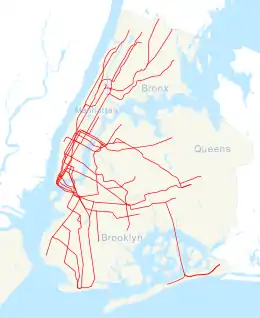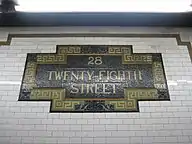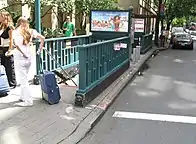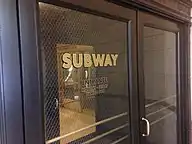28th Street station (IRT Lexington Avenue Line)
28th Street is a local station on the IRT Lexington Avenue Line of the New York City Subway. Located at Park Avenue South and 28th Street in the Rose Hill neighborhood of Manhattan, it is served by 6 trains at all times, <6> trains during weekdays in the peak direction, and 4 trains during late night hours.
28 Street | ||||||||||||||||||||||||||||||||||||||||||||||||||||||||||||||||||||
|---|---|---|---|---|---|---|---|---|---|---|---|---|---|---|---|---|---|---|---|---|---|---|---|---|---|---|---|---|---|---|---|---|---|---|---|---|---|---|---|---|---|---|---|---|---|---|---|---|---|---|---|---|---|---|---|---|---|---|---|---|---|---|---|---|---|---|---|---|
 Downtown platform | ||||||||||||||||||||||||||||||||||||||||||||||||||||||||||||||||||||
| Station statistics | ||||||||||||||||||||||||||||||||||||||||||||||||||||||||||||||||||||
| Address | East 28th Street & Park Avenue South New York, NY 10016[1][2]:1 | |||||||||||||||||||||||||||||||||||||||||||||||||||||||||||||||||||
| Borough | Manhattan | |||||||||||||||||||||||||||||||||||||||||||||||||||||||||||||||||||
| Locale | Rose Hill, Kips Bay | |||||||||||||||||||||||||||||||||||||||||||||||||||||||||||||||||||
| Coordinates | 40.74329°N 73.984165°W | |||||||||||||||||||||||||||||||||||||||||||||||||||||||||||||||||||
| Division | A (IRT) | |||||||||||||||||||||||||||||||||||||||||||||||||||||||||||||||||||
| Line | IRT Lexington Avenue Line | |||||||||||||||||||||||||||||||||||||||||||||||||||||||||||||||||||
| Services | 4 6 | |||||||||||||||||||||||||||||||||||||||||||||||||||||||||||||||||||
| Transit | MTA Bus: BM2, BM3, BM4, BxM3, BxM4, BxM6, BxM7, BxM8, BxM9, BxM10, BxM11, BxM18, QM21 Bee-Line Bus System: 0028 | |||||||||||||||||||||||||||||||||||||||||||||||||||||||||||||||||||
| Structure | Underground | |||||||||||||||||||||||||||||||||||||||||||||||||||||||||||||||||||
| Platforms | 2 side platforms | |||||||||||||||||||||||||||||||||||||||||||||||||||||||||||||||||||
| Tracks | 4 | |||||||||||||||||||||||||||||||||||||||||||||||||||||||||||||||||||
| Other information | ||||||||||||||||||||||||||||||||||||||||||||||||||||||||||||||||||||
| Opened | October 27, 1904[3] | |||||||||||||||||||||||||||||||||||||||||||||||||||||||||||||||||||
| Closed | July 16, 2018 (reconstruction) | |||||||||||||||||||||||||||||||||||||||||||||||||||||||||||||||||||
| Rebuilt | January 14, 2019 | |||||||||||||||||||||||||||||||||||||||||||||||||||||||||||||||||||
| Station code | 404[4] | |||||||||||||||||||||||||||||||||||||||||||||||||||||||||||||||||||
| Accessible | ||||||||||||||||||||||||||||||||||||||||||||||||||||||||||||||||||||
| Opposite- direction transfer | No | |||||||||||||||||||||||||||||||||||||||||||||||||||||||||||||||||||
| Traffic | ||||||||||||||||||||||||||||||||||||||||||||||||||||||||||||||||||||
| 2019 | 5,834,989[5] | |||||||||||||||||||||||||||||||||||||||||||||||||||||||||||||||||||
| Rank | 73 out of 424[5] | |||||||||||||||||||||||||||||||||||||||||||||||||||||||||||||||||||
| Station succession | ||||||||||||||||||||||||||||||||||||||||||||||||||||||||||||||||||||
| Next north | 33rd Street: 4 | |||||||||||||||||||||||||||||||||||||||||||||||||||||||||||||||||||
| Next south | 23rd Street: 4 | |||||||||||||||||||||||||||||||||||||||||||||||||||||||||||||||||||
| ||||||||||||||||||||||||||||||||||||||||||||||||||||||||||||||||||||
| ||||||||||||||||||||||||||||||||||||||||||||||||||||||||||||||||||||
| ||||||||||||||||||||||||||||||||||||||||||||||||||||||||||||||||||||
| ||||||||||||||||||||||||||||||||||||||||||||||||||||||||||||||||||||
28th Street Subway Station (IRT) | ||||||||||||||||||||||||||||||||||||||||||||||||||||||||||||||||||||
| MPS | New York City Subway System MPS | |||||||||||||||||||||||||||||||||||||||||||||||||||||||||||||||||||
| NRHP reference No. | 05000230[2] | |||||||||||||||||||||||||||||||||||||||||||||||||||||||||||||||||||
| Added to NRHP | March 30, 2005 | |||||||||||||||||||||||||||||||||||||||||||||||||||||||||||||||||||
Built for the Interborough Rapid Transit Company (IRT), the 28th Street station was constructed as part of the city's first subway line, which was approved in 1900. Construction on the segment of the line that includes the 28th Street station started on September 12 of the same year. The station opened on October 27, 1904, as one of the original 28 stations of the New York City Subway. The station's platforms were lengthened in the late 1940s.
The 28th Street station contains two side platforms and four tracks; express trains use the inner two tracks to bypass the station. The station was built with tile and mosaic decorations, which are continued along the platform extensions. The platforms contain exits to 28th Street and Park Avenue, as well as to the New York Life Building. The platforms are not connected to each other within fare control. The station is listed on the National Register of Historic Places.
History
Construction and opening
Planning for the city's first subway line dates to the Rapid Transit Act, authorized by the New York State Legislature in 1894.[6]:139–140 The subway plans were drawn up by a team of engineers led by William Barclay Parsons, chief engineer of the Rapid Transit Commission. It called for a subway line from New York City Hall in lower Manhattan to the Upper West Side, where two branches would lead north into the Bronx.[7]:3 A plan was formally adopted in 1897, and legal challenges were resolved near the end of 1899.[6]:148 The Rapid Transit Construction Company, organized by John B. McDonald and funded by August Belmont Jr., signed Contract 1 with the Rapid Transit Commission in February 1900,[8] in which it would construct the subway and maintain a 50-year operating lease from the opening of the line.[6]:182 In 1901, the firm of Heins & LaFarge was hired to design the underground stations.[7]:4 Belmont incorporated the Interborough Rapid Transit Company (IRT) in April 1902 to operate the subway.[6]:182
The 28th Street station was constructed as part of the IRT's original line, particularly the section from Great Jones Street to 41st Street. Construction on this section of the line began on September 12, 1900. The section from Great Jones Street to a point 100 feet (30 m) north of 33rd Street had been awarded to Holbrook, Cabot & Daly Contracting Company, while the remaining section to 41st Street was to be done by Ira A. Shaker.[8] The 28th Street station opened on October 27, 1904, as one of the original 28 stations of the New York City Subway from City Hall to 145th Street on the Broadway–Seventh Avenue Line.[6]:186[3]
20th century

After the initial system was completed in 1908,[9] the station was served by local trains along both the West Side (now the Broadway–Seventh Avenue Line to Van Cortlandt Park–242nd Street) and East Side (now the Lenox Avenue Line). West Side local trains had their southern terminus at City Hall during rush hours and South Ferry at other times, and had their northern terminus at 242nd Street. East Side local trains ran from City Hall to Lenox Avenue (145th Street).[10] In 1918, the Lexington Avenue Line opened north of Grand Central–42nd Street, thereby dividing the original line into an "H" system. All local trains were sent via the Lexington Avenue Line, running along the Pelham Line in the Bronx.[11]
In 1909, to address overcrowding, the New York Public Service Commission proposed lengthening platforms at stations along the original IRT subway.[12]:168 On January 18, 1910, a modification was made to Contracts 1 and 2 to lengthen station platforms to accommodate ten-car express and six-car local trains. In addition to $1.5 million (equivalent to $41.2 million in 2019) spent on platform lengthening, $500,000 (equivalent to $13,719,643 in 2019) was spent on building additional entrances and exits. It was anticipated that these improvements would increase capacity by 25 percent.[13]:15 Platforms at local stations, such as the 28th Street station, were lengthened by between 20 to 30 feet (6.1 to 9.1 m). Both platforms were extended to the north and south.[13]:108
On August 6, 1927, bombs exploded at the 28th Street station and at the 28th Street station on the Broadway Line. The perpetrator of the bombings is unknown; they were initially blamed on Galleanists (as Sacco and Vanzetti had been denied appeal three days prior), though police later believed they were unrelated.[14][15][16] With the completion of the New York Life Building between 26th and 27th Streets in 1928,[17] a new entrance opened from the building's basement to the southbound platform.[18][19][20]
On April 13, 1948, the platform extensions to accommodate ten-car trains at this station, along with those at 23rd Street, and 33rd Street, were opened for use.[21]
In 1987, the Metropolitan Transportation Authority (MTA) allocated $31 million to renovate 44 stations across the subway system, including the 28th Street station.[22] The station's original tiles, which were peeling off, were entirely replaced.[23] At the fare control area, glass block walls were installed above the turnstiles.[23][24] New tiles were also installed on the floors and walls of the fare control areas.[2]:8[22] To deter fare evaders from sneaking through the emergency exit "slam gates" at each fare-control area, electronically activated gates were installed beside the existing turnstiles.[23] The staircases to street level were rebuilt as well.[2]:8 The work was completed by early 1989,[22] having been delayed by nine months because of setbacks in the delivery of new light fixtures.[24]
21st century
The 28th Street station has been listed on the National Register of Historic Places since 2005.[2] A staircase and elevator from street level to the southbound platform was added with the construction of 400 Park Avenue South, a residential tower at the southwestern corner of Park Avenue South and 28th Street.[25] The tower was completed in 2015.[26]
Under the 2015–2019 MTA Capital Plan, the station underwent a complete overhaul as part of the Enhanced Station Initiative, and was entirely closed for several months. Updates included cellular service, Wi-Fi, USB charging stations, interactive service advisories and maps.[27][28] In January 2018, the NYCT and Bus Committee recommended that Judlau Contracting should receive the $125 million contract for the renovations of 57th and 23rd Streets on the IND Sixth Avenue Line; 28th Street on the IRT Lexington Avenue Line, and 34th Street–Penn Station on the IRT Broadway–Seventh Avenue Line and IND Eighth Avenue Line.[29] However, the MTA Board temporarily deferred the vote for these packages after city representatives refused to vote to award the contracts.[30][31] The contract was put back for a vote in February, where it was ultimately approved.[32] The station was closed for renovations on July 16, 2018, and reopened to the public January 14, 2019,[33] delayed from December 2018.[34]
Station layout
| G | Street level | Entrances/exits |
| P Platform level |
Side platform | |
| Northbound local | ← ← | |
| Northbound express | ← | |
| Southbound express | | |
| Southbound local | | |
| Side platform | ||
Like other local stations, 28th Street has four tracks and two side platforms. The 6 stops here at all times,[35] rush-hour and midday <6> trains stop here in the peak direction;[35] and the 4 stops here during late nights.[36] The two express tracks are used by the 4 and 5 trains during daytime hours.[37] The platforms were originally 200 feet (61 m) long, as at other local stations on the original IRT,[7]:4[2]:3 but later became 520 feet (160 m) long.[21] The platform extensions are at both ends of the original platforms.[38]:35
The express tracks stay level, while the local tracks slowly incline into the station to allow for the easier deceleration of local trains. As such, the express tracks are at a slightly lower elevation than the local tracks.[2]:6
Design
As with other stations built as part of the original IRT, the tunnel is covered by a "U"-shaped trough that contains utility pipes and wires. The bottom of this trough contains a foundation of concrete no less than 4 inches (100 mm) thick.[2]:5–6[38]:9 Each platform consists of 3-inch-thick (7.6 cm) concrete slabs, beneath which are drainage basins. The original platforms contain I-beam columns spaced every 15 feet (4.6 m), while the platform extensions contain columns with white glazed tiles. Additional columns between the tracks, spaced every 5 feet (1.5 m), support the jack-arched concrete station roofs.[2]:5–6[7]:4[38]:9 There is a 1-inch (25 mm) gap between the trough wall and the platform walls, which are made of 4-inch (100 mm)-thick brick covered over by a tiled finish.[2]:5–6[38]:9
The fare control is at platform level and there are no open crossunders or crossovers. However, there is a closed crossunder about halfway between each platform, which was constructed during the 1940s and is sealed.[2]:6 The walls along the platforms near the fare control areas consist of a brick wainscoting on the lowest part of the wall, with bronze air vents along the wainscoting, and white glass tiles above. The platform walls are divided at 15-foot (4.6 m) intervals by buff mosaic tile pilasters, or vertical bands. Atop the pilasters are pairs of cruciform faience plaques with the words 28 twenty-eighth street, surrounded by foliate designs and rosettes. The plaque pairings are set within a frame that contains a ventilation opening between each plaque of the pair. A cornice with blue egg-and-dart patterns runs atop these walls.[2]:6–7 The platform extensions are decorated with blue and buff tile bands, and contain blue mosaic tile plaques with the number "28" atop the pilasters. The far southern end of the southbound platform has equare ceramic tiles topped by marble belt courses.[2]:7 The decorative work was performed by faience contractor Grueby Faience Company.[38]:35 The ceilings of the fare control areas once contained plaster molding,[38]:10 although this has been removed.[2]:6 The fare control areas at 28th Street contain various maintenance rooms, and were retiled with large rectangular ceramic blocks in 1989; as of the 2019 renovation, the fare control areas have modern black finishes.[2]:8
Two works of art were installed in this station. The first was a glass block wall artwork at the main fare control entitled Seven Ways 4 Twenty-Eighth. It was installed during station renovations in 1996.[2]:7 The second was Roaming Underfoot, a glass mosaic mural on the platform walls by Nancy Blum. It showcases flora in the Madison Square Park Conservancy's Perennial Collection, and was installed in 2018 during renovations.[39]
Exits
Each platform has exits to 28th Street; the northbound platform's exits are on the eastern side of Park Avenue South while the southbound platform's exits are on the western side. The only control area for the northbound platform is at 28th Street, where four stairs lead to street level, two each to the northeastern and southeastern corners of 28th Street and Park Avenue South.[2]:6[40] These stairs contain simple, modern steel railings like those seen at most New York City Subway stations.[2]:6 These stairs also contain next-train countdown clocks and neighborhood wayfinding maps at the exterior of each entrance, which were installed in the 2019 renovation.[41]
The main fare control area for the southbound platform is also at 28th Street, where a stair leads up to 45 East 28th Street on the north side of that street, and a stair and elevator lead up to 50 East 28th Street on the south side of the same street.[40] The entrance inside 50 East 28th Street replaced two staircases that led to the southwestern corner of 28th Street and Park Avenue South, right outside the building.[2]:6
A second fare control area at the southern end of the southbound platform leads to the basement of the New York Life Building, between 26th and 27th Streets.[18] It is only open from 7 a.m. to 7 p.m. on weekdays.[42] The New York Life Building entrance has an Art Deco inspired interborough subway sign hanging from the facade of that building.[2]:8[42][43]
References
- "Borough of Manhattan, New York City". Government of New York City. Retrieved December 28, 2020.
- "New York MPS 28th Street Subway Station (IRT)". Records of the National Park Service, 1785 - 2006, Series: National Register of Historic Places and National Historic Landmarks Program Records, 2013 - 2017, Box: National Register of Historic Places and National Historic Landmarks Program Records: New York, ID: 75313917. National Archives.
- "Our Subway Open: 150,000 Try It; Mayor McClellan Runs the First Official Train". The New York Times. October 28, 1904. p. 1. ISSN 0362-4331. Retrieved April 21, 2020.
- "Station Developers' Information". Metropolitan Transportation Authority. Retrieved June 13, 2017.
- "Facts and Figures: Annual Subway Ridership 2014–2019". Metropolitan Transportation Authority. 2020. Retrieved May 26, 2020.
- Walker, James Blaine (1918). Fifty Years of Rapid Transit — 1864 to 1917. New York, N.Y.: Law Printing. Retrieved November 6, 2016.
- "Interborough Rapid Transit System, Underground Interior" (PDF). New York City Landmarks Preservation Commission. October 23, 1979. Retrieved November 19, 2019.
- Report of the Board of Rapid Transit Railroad Commissioners for the City of New York For The Year Ending December 31, 1904 Accompanied By Reports of the Chief Engineer and of the Auditor. Board of Rapid Transit Railroad Commissioners. 1905. pp. 229–236.
- "Our First Subway Completed At Last — Opening of the Van Cortlandt Extension Finishes System Begun in 1900 — The Job Cost $60,000,000 — A Twenty-Mile Ride from Brooklyn to 242d Street for a Nickel Is Possible Now". The New York Times. August 2, 1908. p. 10. Retrieved November 6, 2016.
- Brooklyn Daily Eagle Almanac. Brooklyn Daily Eagle. 1916. p. 119.
- "Open New Subway Lines to Traffic; Called a Triumph — Great H System Put in Operation Marks an Era in Railroad Construction — No Hitch in the Plans — But Public Gropes Blindly to Find the Way in Maze of New Stations — Thousands Go Astray — Leaders in City's Life Hail Accomplishment of Great Task at Meeting at the Astor" (PDF). The New York Times. August 2, 1918. p. 1. Retrieved November 6, 2016.
- Hood, Clifton (1978). "The Impact of the IRT in New York City" (PDF). Historic American Engineering Record. pp. 146–207 (PDF pp. 147–208). Retrieved December 20, 2020.
 This article incorporates text from this source, which is in the public domain.
This article incorporates text from this source, which is in the public domain. - Report of the Public Service Commission for the First District of the State of New York For The Year Ending December 31, 1910. Public Service Commission. 1911.
- Joughin, Louis; Morgan, Edmund M. The Legacy of Sacco and Vanzetti. Princeton University Press. p. 273. ISBN 9781400868650 – via Google Books.
- Carroll, Michael P. (Winter 2020). "The Forgotten Story of the Bombings of the Italian Church of Saints Peter and Paul in San Francisco". Italian American Review. 10 (1): 36. doi:10.5406/italamerrevi.10.1.0019.
- "Probe of Bombings Turns to Boston". Boston Globe. August 9, 1927. p. 8 – via Newspapers.com
 .
. - "Huge Home Opened by New York Life; New Home of New York Life Insurance Co". The New York Times. December 13, 1928. ISSN 0362-4331. Retrieved February 26, 2020.
- "Historic Structures Report: New York Life Building". National Register of Historic Places, National Park Service. June 2, 1978. p. 5. Retrieved December 25, 2020.
- Stern, Robert A. M.; Gilmartin, Patrick; Mellins, Thomas (1987). New York 1930: Architecture and Urbanism Between the Two World Wars. New York: Rizzoli. p. 542. ISBN 978-0-8478-3096-1. OCLC 13860977.
- "May Raze Garden for a Skyscraper". Brooklyn Times-Union. May 17, 1924. p. 3. Retrieved February 26, 2020 – via newspapers.com
 .
. - Report for the three and one-half years ending June 30, 1949. New York City Board of Transportation. 1949. hdl:2027/mdp.39015023094926.
- Dwyer, Jim (April 6, 1988). "In the Subways; Polish Job for Antique Stations". Newsday. p. 07. Retrieved January 1, 2021 – via ProQuest.
- Sims, Calvin (June 9, 1990). "Plans and Costs Expand To Fix Subway Stations". The New York Times. ISSN 0362-4331. Retrieved January 22, 2021.
- Gordy, Molly (August 23, 1988). "Subway Station Restoration Is Year Late, Double Budget". Newsday. p. 03. Retrieved January 1, 2021 – via ProQuest.
- "400 park avenue south". Lendlease. Retrieved January 25, 2021.
- "Prism Tower". The Skyscraper Center. April 7, 2016. Retrieved January 25, 2021.
- Whitford, Emma (January 8, 2016). "MTA Will Completely Close 30 Subway Stations For Months-Long "Revamp"". Gothamist. Archived from the original on March 23, 2020. Retrieved July 18, 2016.
- "MTA Stations" (PDF). governor.ny.gov. Government of the State of New York. Archived (PDF) from the original on November 2, 2019. Retrieved July 18, 2016.
- Transit & Bus Committee Meeting (PDF). New York City Transit and Bus Committee Meeting. Metropolitan Transportation Authority. January 22, 2018. p. 135. Archived (PDF) from the original on April 29, 2020. Retrieved January 19, 2018.
- Barone, Vincent (January 24, 2018). "Subway station upgrades in Manhattan, Bronx on hold after MTA board tables vote". am New York. Archived from the original on October 10, 2019. Retrieved January 25, 2018.
- Siff, Andrew (January 24, 2018). "MTA Shelves Plan to Modernize Subway Stations Amid Criticism". NBC New York. Archived from the original on April 29, 2020. Retrieved January 25, 2018.
- "Foes Hit Gov's Station Fix Plan". NY Daily News. February 13, 2018. Retrieved February 23, 2018.
- "Planned Service Changes for: Monday, January 14, 2019". mta.info. Metropolitan Transportation Authority. January 14, 2019. Archived from the original on January 14, 2019. Retrieved December 20, 2018.
- "Repairs and Improvements Coming to Three Manhattan 6FM Subway Stations" (Press release). New York: Metropolitan Transportation Authority. June 15, 2018. Archived from the original on September 4, 2019. Retrieved June 18, 2018.
- "6 Subway Timetable, Effective September 13, 2020". Metropolitan Transportation Authority. Retrieved December 9, 2020.
- "4 Subway Timetable, Effective September 13, 2020". Metropolitan Transportation Authority. Retrieved December 9, 2020.
- Dougherty, Peter (2006) [2002]. Tracks of the New York City Subway 2006 (3rd ed.). Dougherty. OCLC 49777633 – via Google Books.
- Framberger, David J. (1978). "Architectural Designs for New York's First Subway" (PDF). Historic American Engineering Record. pp. 1-46 (PDF pp. 367-412). Retrieved December 20, 2020.
 This article incorporates text from this source, which is in the public domain.
This article incorporates text from this source, which is in the public domain. - "28th Street - Nancy Blum - Roaming Underfoot, 2019". web.mta.info. Metropolitan Transportation Authority. Archived from the original on September 14, 2020. Retrieved September 14, 2020.
- "MTA Neighborhood Maps: 28 St (6)". Metropolitan Transportation Authority. 2018. Retrieved December 25, 2020.
- "Enhanced Stations Initiative: Community Board 6" (PDF). cbsix.org. Metropolitan Transportation Authority. June 13, 2018. p. 11. Retrieved November 19, 2018.
- "NYC's Most Opulent Subway Entrance". Forgotten NY. January 19, 2014. Retrieved December 25, 2020.
- Presa, Donald G. (October 24, 2000). "New York Life Insurance Company Building" (PDF). New York City Landmarks Preservation Commission. p. 9. Retrieved December 25, 2020.
Further reading
External links
| Wikimedia Commons has media related to 28th Street (IRT Lexington Avenue Line). |
- nycsubway.org – IRT East Side Line: 28th Street
- nycsubway.org – 7 waves 4 twenty eight Artwork by Gerald Marks (1996)
- Forgotten NY – Original 28 - NYC's First 28 Subway Stations
- 28th Street entrance from Google Maps Street View
- 26th-27th Streets entrance from Google Maps Street View
- Platforms from Google Maps Street View












